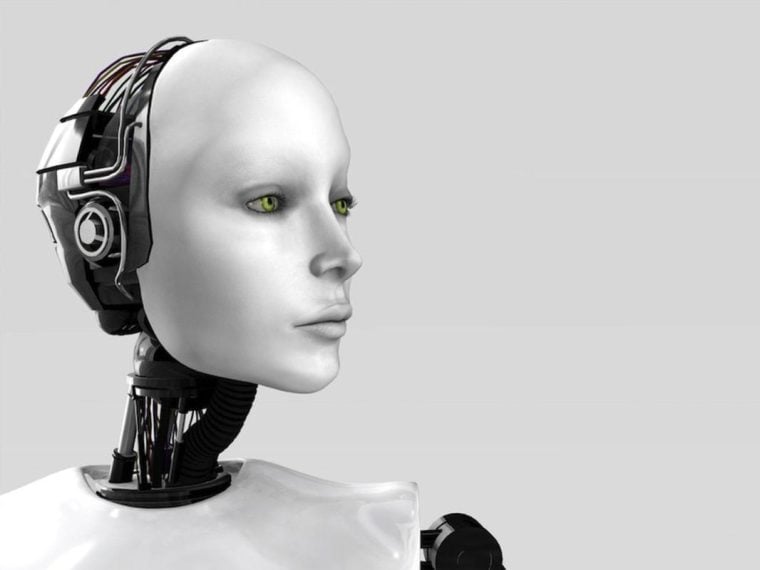We've ranked the best Robotics colleges across the U.S. This ranking is designed for students, parents, college guidance counselors and others to be informed of the best options for studying Robotics. Many of these schools offer bachelors and masters degrees in Robotics. We have included labs and research opportunities where they are relevant.
The thriving robotics industry has inspired many colleges and universities to provide high quality Robotics programs.
Some schools offer robotics-related undergraduate and graduate degree programs in mechanical engineering, electrical engineering or computer programming, which also teach Robotics within their curriculum. Colleges in this list include undergrad and graduate programs in Robotics and related technical subjects, such as Engineering and Machine Learning, and relevant labs where students can learn Robotics hands-on.
Robotics instruction is often closely connected with Artificial Intelligence and Machine Learning.
Schools may download our badge.
The Best Robotics Colleges
Carnegie Mellon University
The Robotics Institute
Pittsburgh, Pennsylvania
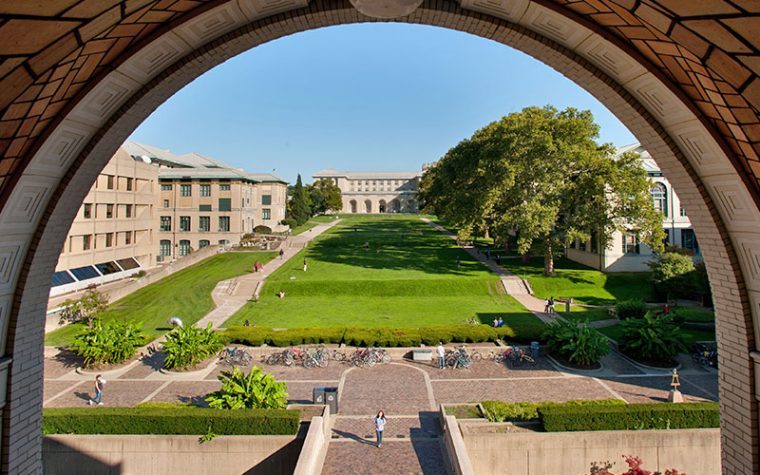
Carnegie Mellon University, a private research university, averages a 13-14% acceptance rate. The university is the fourth largest in Pittsburgh based on number of students.
The school that Andrew Carnegie founded in 1900 has grown to include these colleges:
- Engineering
- Fine Arts
- Dietrich College of Humanities and Social Sciences
- Mellon College of Science
- Tepper School of Business
- H. John Heinz III College of Information Systems and Public Policy
- School of Computer Science
Entrenched in the world of robotics since 1979 when they opened The Robotics Institute, Carnegie Mellon has been leading in Robotics research and education.
Carnegie Mellon offers the following degree options:
- Robotics as an additional major
- Minor in Robotics
- Bachelor of Science in Robotics
- Master of Science
- PhD program
The Additional Major is available to students taking any major within Carnegie Mellon University. Students learn control and motion of robots as their foundation, which is overlaid with cognition, sensing, and action.
The School of Computer Science offers a Bachelor of Science in Robotics. This on-campus bachelor's teaches “systems thinking” and solving problems in real world scenarios.
Robotics Master's Research Program: Students complete a compilation of course requirements, electives, and supervised research. Students complete a public thesis talk and a Master's thesis document as the capstones of the program.
During the program, students gain a broad-level understanding of the robotics field, but they also select a specialization area. Some of the possible selections include Haptics, Human-Robot Interactions, and Machine Learning. The core learning a student participates in comes from the following divisions: Perception, Cognition, Action, and Math Foundations. Students can complete the entire program in 24 months.
Graduates of the program can seek a career in the research field with companies such as NASA or Google, or they can continue their studies to a doctorate program.
The PhD in Robotics is a terminal degree, and teaches how to formulate the necessary problems and research solutions in robotics.
Research is conducted in the laboratories of the Robotics Institute under the supervision of faculty advisers and in collaboration with student colleagues. Students in the PhD program are awarded a yearly graduate fellowship, which includes tuition, activity fees, and a stipend, as long as they maintain good standing in the program.
Robotics Institute
The Robotics Institute conducts research on robotics in a wide array of fields, including:
- Aerial Robotics
- Mining Robotics
- Robotics for Scientific Discovery
- Search and Rescue Robotics
- Underwater Robotics
University of Pennsylvania
General Robotics, Automation, Sensing and Perception (GRASP) Laboratory
Philadelphia, Pennsylvania
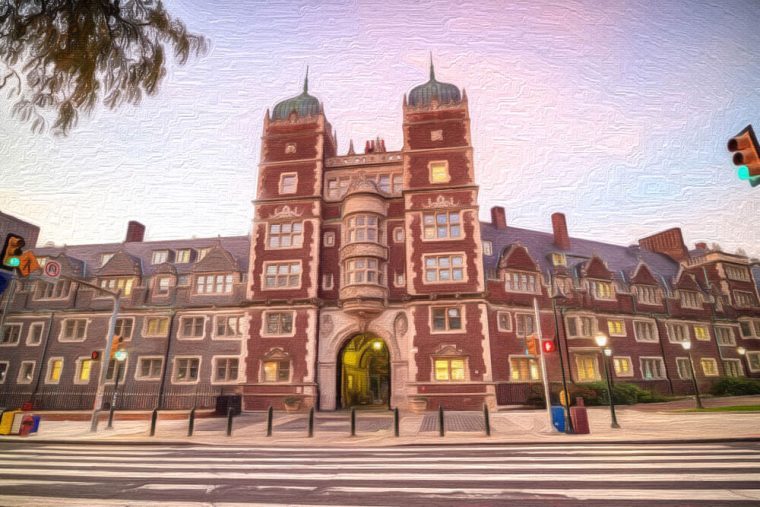
Established in 1740, the University of Pennsylvania, or "Penn", is the fourth oldest university in the United States, and the first to offer both graduate and undergraduate studies. The school was one of only nine universities to receive a charter before the American Revolution.
Penn offers a master's degree in Robotics (ROBO). It is an interdisciplinary degree taken through the following departments:
- Electrical and Systems Engineering
- Computer and Information Science
- Mechanical Engineering and Applied Mechanics
The School of Engineering and Applied Science has a General Robotics, Automation, Sensing and Perception (GRASP) laboratory, which administers this master's degree.
The GRASP Lab was an early adopter of the idea of robotics, getting its start in 1979.
Students learn the technological and scientific aspects of robotics, which include these subjects:
- perception
- machine learning
- vision
- control
- automation
Course include:
- Advanced Robotics
- Model Predictive Control
- Applied Machine Learning
- Design of Mechatronic Systems
University of Cincinnati-Main Campus
College of Engineering and Applied Science
Cincinnati, Ohio
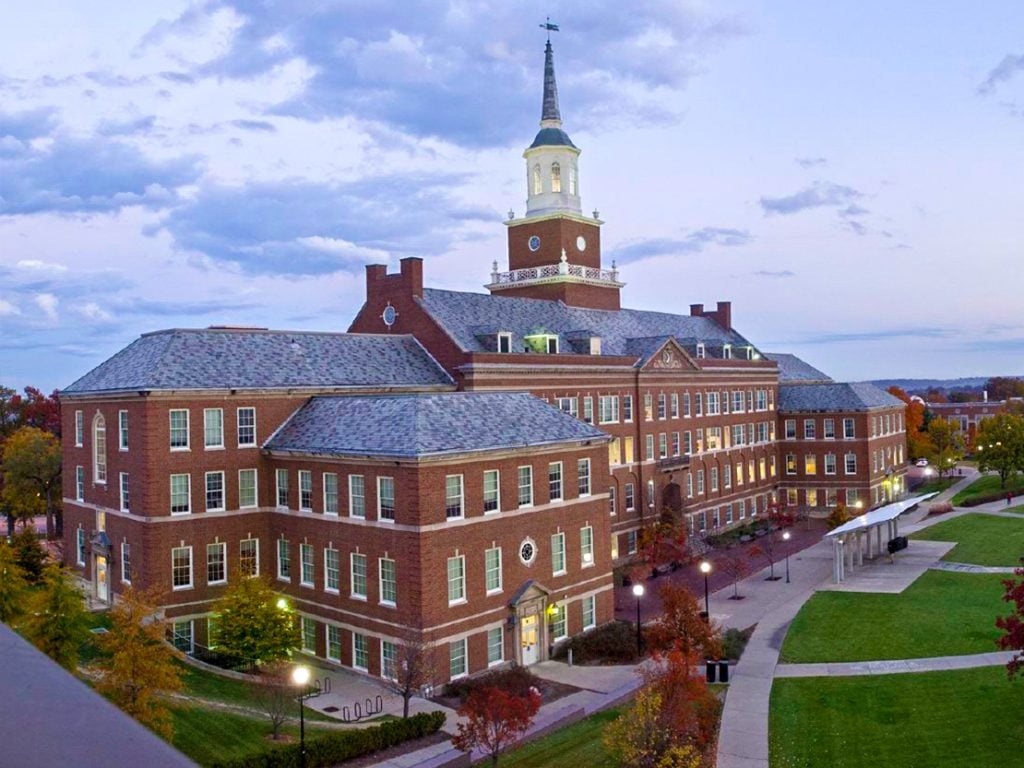
The University of Cincinnati offers the online Master of Engineering in Robotics & Intelligent Autonomous Systems degree.
The Master of Engineering (MEng) program provides specialized training to students in computer science, electrical engineering, mechanical engineering, systems engineering, and project management to develop multidisciplinary skills necessary for building reliable, safe, secure, and trusted systems.
Unlike traditional Master of Science degrees, the MEng program focuses on enhancing skills and expertise to better serve working professionals, rather than culminating in a research experience and thesis.
The degree provides advanced training to expand knowledge and expertise, with the curriculum tailored to focus on either depth of understanding or interdisciplinary breadth.
The MEng program is practice-oriented and focused, catering to the need for highly skilled practicing engineers who are flexible in their professional capabilities in today's competitive technology environment.
University of Michigan-Ann Arbor
College of Engineering, Robotics Department
Ann Arbor, Michigan
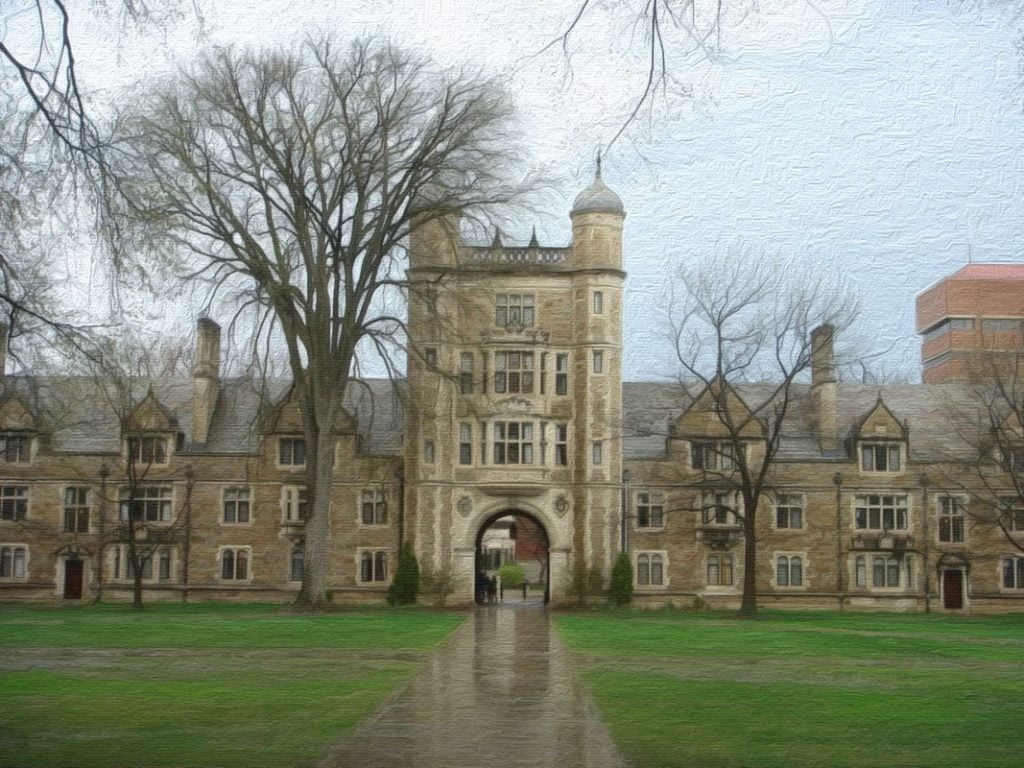
The University of Michigan's Robotics Department offers a Bachelor of Science In Engineering - Robotics degree.
The BSE in Robotics focuses on three main essential disciplines: Sensing the environment, reasoning to make decisions, and acting to produce motion or other outputs.
Courses include:
- Intro Autonomous Robotics
- Design for Human-Robot Interaction
- Robotics Mechanisms
- Robot Sensors & Signals
- Intro to Human-Robot Systems
- Autonomous Robotics Laboratory
- Robot Operating Systems
A Master of Science and a PhD in Robotics are also offered. These graduate degrees build on the three main sub-disciplines: sensing, reasoning, and acting.
The MS in Robotics is 30 credit hours.
Courses areas include:
- Robotic Systems Laboratory
- Inference Estimation and Learning
- Autonomous Robotics
- Advanced Topics in Computer Vision
- Machine Learning
- Dynamics and Control of Spacecraft
PhD students may earn their master's within the doctorate program. For students that already have a master's, the PhD program requires 26 credit hours. PhD students must devise an original research topic, write a thesis on it, and defend it.
Cornell University
Ithaca, New York
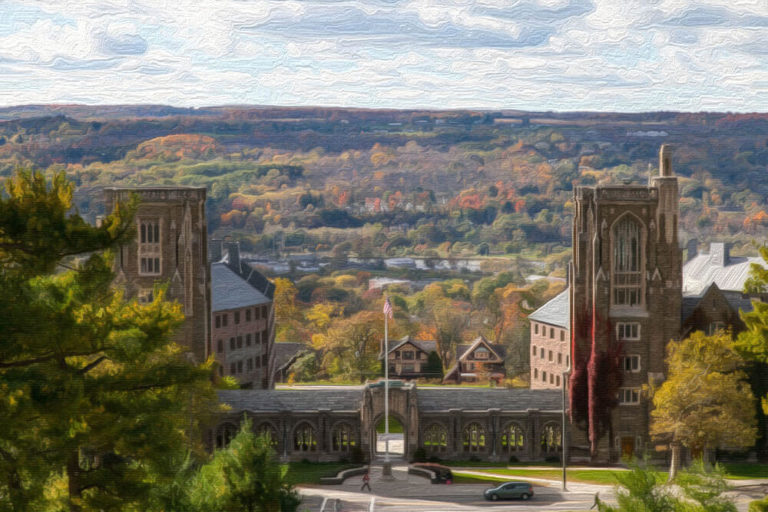
Cornell University is a private, land-grant, sea-grant, space-grant and research institution. Ezra Cornell and Andrew Dickson White established the University in 1865 with the desire to educate and contribute to all fields of knowledge.
Cornell offers a Robotics Minor, which is available to all undergraduate students.
Courses include:
- Foundations of Robotics
- Introduction to Robotic Mobile Manipulation
- Human-Robot Interaction
- Introduction to Cognitive Science
- Architectural Robotics
- Mechatronics
The Sibley School of Mechanical and Aerospace Engineering offer a Master of Arts in Engineering with a focus on Robotics.
This degree is tailored to the goals and educational aspirations of the students. Students learn Robotics in these domains (among others):
- controls
- microcontrollers
- human-robot interaction
- dynamics and structures
Courses include:
- Architectural Robotics
- Autonomous Mobile Robots
- Multivariable Control Theory
Graduates have worked in many professional robotics capacities, which include Ori Living, Honeybee Robotics, ExynAero, Knightscope, and Stryker.
Cornell also offers a Robotics PhD:
The curriculum for the program is based on several required courses, complemented by one minor in the student’s field and another minor that can be chosen from any of the minors at Cornell. The required courses consist of courses in the foundation of robotics, community-engaged research, and ethics. The rest of the curriculum is shaped by the interests of each Ph.D. student. Each student will be required to complete a sufficient number of courses to satisfy two minors.
Cornell University
Students studying robotics at Cornell University can learn about various facets of Robotics including perception, learning, control, and human-robot interaction. The team utilizes several robots for research and learning purposes: aerial robots, humanoids, office and home assistant robots, and autonomous cars, among others.
Some of the background courses helpful in the Robotics field offered at the University include Intro to Computer Science using Robots, Intellectual Physical Systems and Foundations of Robots.
Some of the intermediate and advanced courses include Autonomous Mobile Robots, Human-Robot Interaction, Foundations of Robotics, Computer Vision, and Machine Learning for Intelligent Systems.
Georgia Institute of Technology-Main Campus
Atlanta, Georgia
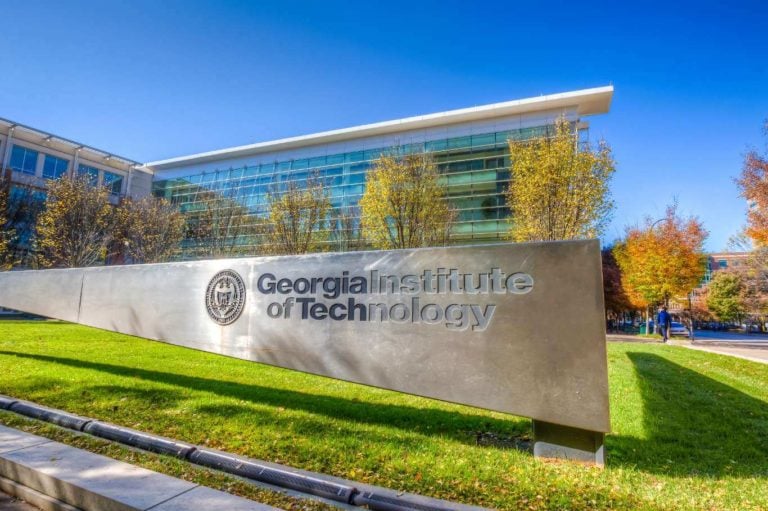
The Georgia Institute of Technology, a public university founded in 1885 and commonly referred to as Georgia Tech, has grown to accommodate a student body of nearly 30,000 individuals. The university has six colleges, but still has an emphasis on sciences and technology and is well-known for engineering, computing, business administration, sciences, design and liberal arts programs.
Georgia Tech manages the Institute for Robotics and Intelligent Machines.
Georgia Tech offers a Master of Science and a PhD in Robotics, and an undergraduate summer program for underrepresented minorities. The School also has a traineeship program involving healthcare robotics.
The Institute serves as an umbrella to cover individuals studying any and all disciplines and who have an interest in robotics. Through the joint venture, the Institute achieves new strengths as inter-disciplinary individuals come together and solve problems with maximum collaboration and creativity.
California Institute of Technology
Pasadena, California

California Institute of Technology (Caltech), a private school, manages and operates NASA's Jet Propulsion Laboratory. Among the six academic divisions, Caltech places a strong emphasis on the engineering and science departments. The School has over 2,000 students and 300 faculty members. Caltech encourages interdisciplinary research.
The Department of Computing and Mathematical Sciences at Caltech, consistently ranked among the best, has over 20 faculty members and 150 students (including both graduate and undergraduate).
Robotics programs:
- Additional Major in Robotics
- Undergraduate Minor in Robotics
- PhD and Master of Science in Robotics
Students who choose the robotics research area at Caltech can expect to take courses such as:
- Control System Design
- Introduction to Kinematics and Robotics
- Advanced Robotics: Navigation and Vision
- Advanced Networking
Caltech provides courses taught by some of the leading experts responsible for supplying technology options for robotic space missions.
Some related research areas of the department include Information Theory and Signal Processing, Robotics and Autonomous Control, Statistics and Machine Learning, and Computational Neuroscience and Neural Engineering.
University of Utah
Salt Lake City, Utah
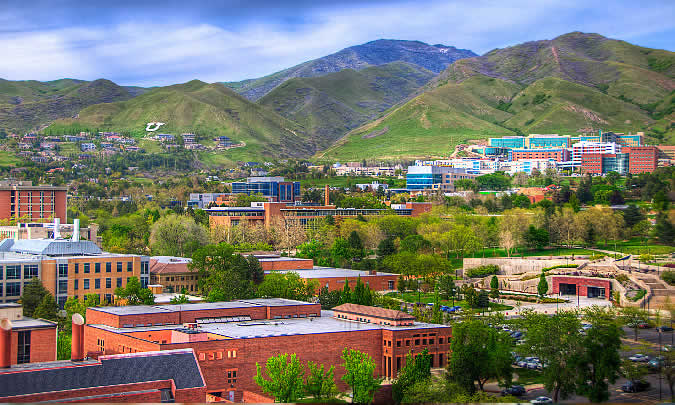
The University of Utah, founded in 1850, has over 30,000 students. The University offers over 100 undergrad majors and nearly 100 graduate degree options. The University boasts both a law school and Utah's only medical school among its graduate programs.
The school also participates in Division I athletics and has graduated four Nobel Prize winners, two astronauts, and 22 Rhodes Scholars.
The University of Utah offers a variety of Robotics programs. These Robotics programs include a Ph.D., an M.S. Thesis, an M.S. Project option, an undergraduate minor, a certificate in Robotics, and a graduate certificate in Robotics for students pursuing traditional engineering and computer-science degrees.
Students with strong mathematics backgrounds and strong programming skills have seen success in the robotics courses. Robotics students complete courses including the basics of robotics work: mechanics, control, and motion planning.
Students also participate in Perception, Cognition and Action courses. Beyond those requirements, students have some freedom to select elective courses in a way to bolster their specific interests and specialties.
University of Southern California
Los Angeles, California
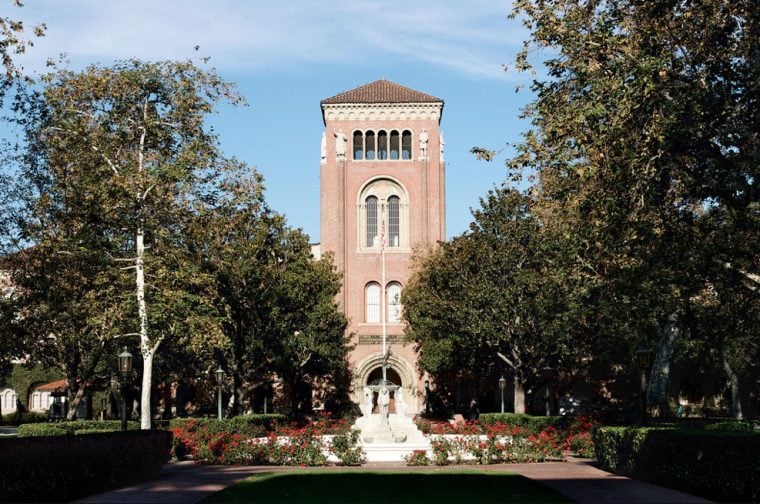
Founded in 1880, the University of Southern California is California's oldest private research university.
USC houses the Robotics and Autonomous Systems Center (RASC). The RASC serves as an organized research unit intended for multi-discipline use within the College of Engineering.
Within the department of Computer Science, USC offers a Master of Science in Computer Science (Intelligent Robotics).
While earning their Intelligent Robotics degree, students complete courses such as:
- Analysis of Algorithms
- Robotics, Self-Organization
- Machine Learning and Probabilistic Learning
The graduate degree exposes students to the design and construction of robots, and to the computer systems required for control and information processing.
The lab members focus their research on the far-reaching field of technology of robotics systems. The research impacts areas at USC such as humanoid, reconfigurable, and nano and space robotics, and applications such as training, rehabilitation, emergency response and entertainment.
South Dakota School of Mines and Technology
Rapid City, South Dakota
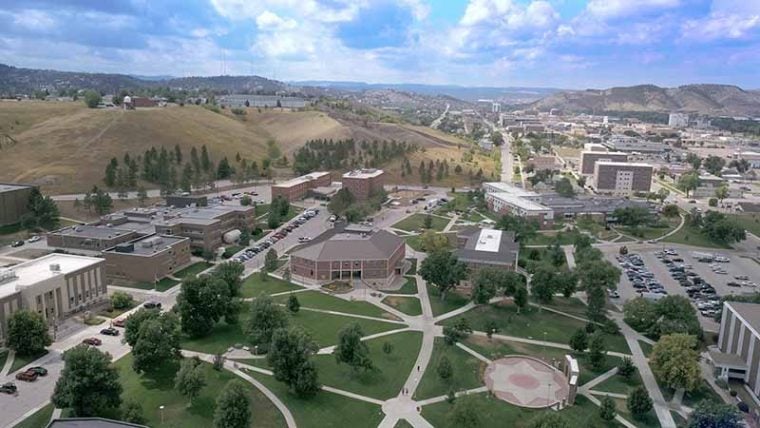
In 1885 the Dakota School of Mines taught the technology of mining. The curriculum grew and the Dakota School of Mines became the South Dakota School of Mines and Technology in 1943.
Undergraduate and graduate courses offered in Artificial Intelligence and Intelligent Systems. Graduate focus is on Artificial Intelligence. Several faculty are involved in the research in Artificial Intelligence.
The Master of Science in Computational Sciences and Robotics provides an overview of Artificial Intelligence, robotics, and more. Students take courses in Computer Engineering, Computer Science, and Mechanical Engineering.
Labs:
- Experimental and Computational Mechanic Laboratory
- Advance Manufacturing Process Technology Transition and Training center
- Security Printing and Anti-Counterfeiting Technology center
Oregon State University
Corvallis, Oregon
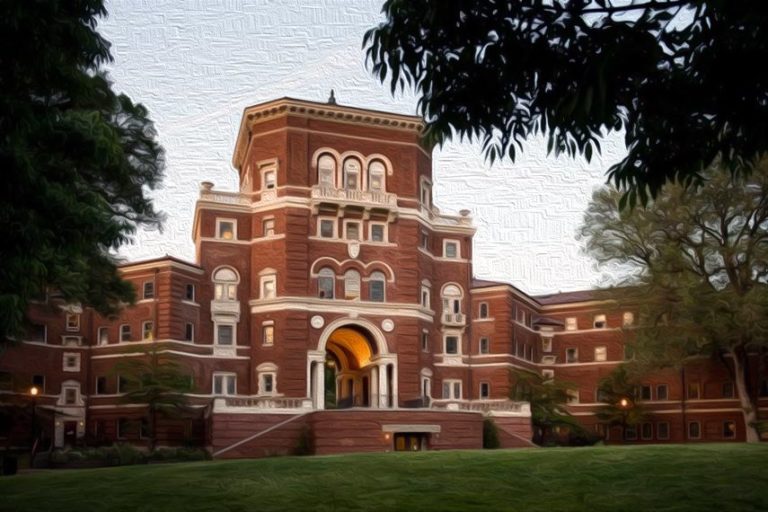
Oregon State University (OSU), founded in 1868, is one of only three American institutions designated as a land-grant, sea-grant, space-grant and sun-grant university. It is one of only two public universities with all four designations, along with Penn State.
OSU enrolls over 30,000 students, including over 25,000 undergraduates. Oregon State University has adopted the position robots are here to stay, thus the educational system must adapt to create the next generation of researchers and innovators.
OSU recognizes robotics touch numerous fields - business, engineering, communication, transportation, agriculture, national defense, and medicine. OSU is one of the few institutes of higher education to offer graduate studies in Robotics.
Students may earn a graduate degree in robotics, either a Master's or a Doctorate, through studying the core areas of robotics. These areas include control, sensing, locomotion, actuation, manipulation, human-robot interaction, and artificial intelligence.
Working to develop and harness the potential of robotics in today's world led to the formation of the Collaborative Robotics and Intelligent Systems Institute (CoRIS) at OSU.
OSU faculty members consider their position unique; they approach the idea of robotics holistically - studying technological advancement, while considering how the robots impact people and how the changes brought by the widespread use of robots will shape our society.
Faculty members involved in robotics explore the technical, ethical, social, and economic implications innovations will bring.
Grand Canyon University
College of Science, Engineering, & Technology
Phoenix, Arizona
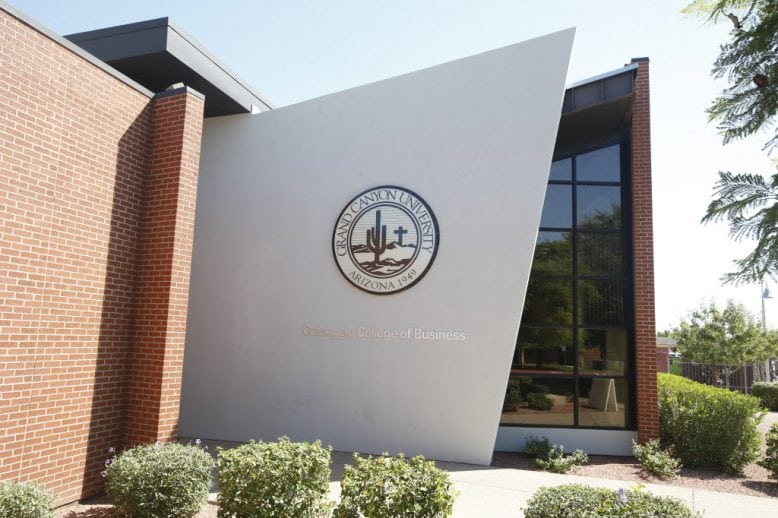
Grand Canyon University, one of the largest universities in the U.S., offers the Bachelor of Science in Engineering: Robotics degree.
This program teaches students Robotics within an Engineering framework, which includes hand-on instruction and projects. Students learn mechanical, electrical, and computer engineering to learn robotics and robotic design. Students also learn programming of robotic systems.
Classes include:
- Applied Robotics & Lab
- Circuits Lab
- Introduction to Robotics & Lab
- Feedback Control Theory and Design & Lab
- Dynamics Lab
The classes last for 15 weeks, and 128 credit hours are required. Grand Canyon accepts up to 90 transfer credits. This program is taken on-campus.
Columbia University in the City of New York
New York, New York
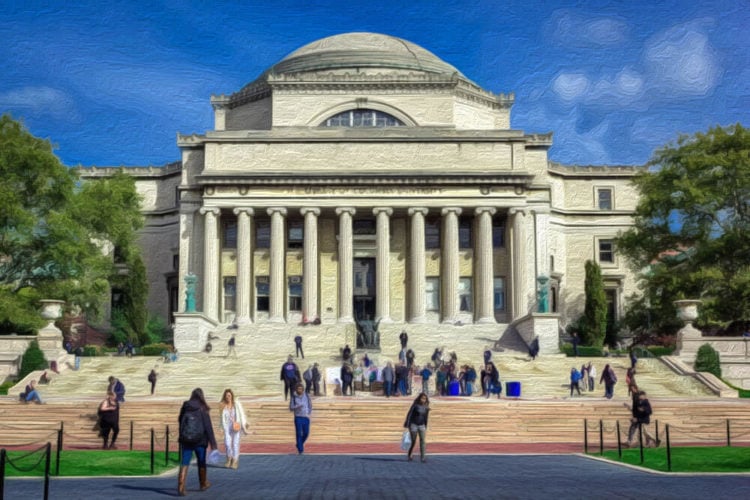
The Fu Foundation School of Engineering and Applied Science manages nine academic departments:
- Applied Physics and Applied Math
- Biomedical Engineering
- Chemical Engineering
- Civil Engineering and Engineering Mechanics
- Computer Science
- Earth and Environmental Engineering
- Electrical Engineering
- Industrial Engineering and Operations Research
- Mechanical Engineering
Each of these departments offers a variety of bachelor, master, and doctoral level degrees relating to robotics in their own unique ways.
In Civil Engineering and Engineering Mechanics, for example, students can study self-driving vehicles, can research and improve the effectiveness of green roofing, and can understand the use of sensors to help maintain bridge safety.
Students in the Mechanical Engineering department deal most directly with human-robot interactions such as improving laser robotic surgery.
Students interested in further research and networking in the field of robotics can connect with the Columbia University Robotics Group.
The Group has several on-going research areas including:
- Multimodal Brain Computer Interface for Human-Robot Interaction
- Surgical Tool Tracking
- Dexterous Manipulation Using Predictive Thin-Shell Modeling
- Protein Streak Seeding
- Visual Servoing: A Partitioned Visual Feedback System
Johns Hopkins University
Baltimore, Maryland
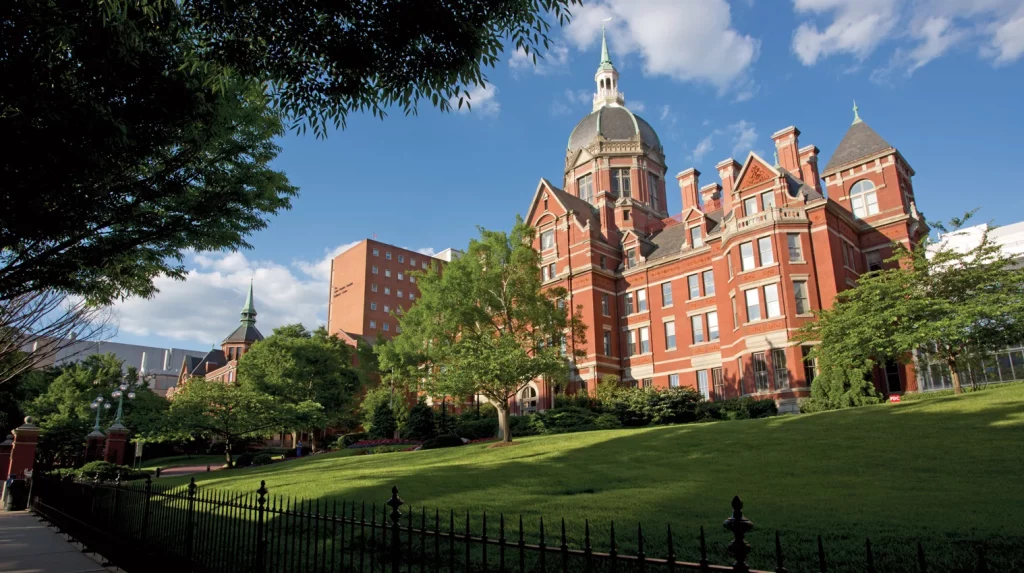
Hopkins University followed the example set by Heidelberg University in Germany to begin their graduate studies program, and hence earned the title of the first research university in the United States.
The private university calls Baltimore home, but the School also has divisions on campuses in Washington, DC, Italy, Singapore and China, allowing the school to reach over 20,000 students. Hopkins University offers robotics as either a minor or a Master's degree through their Laboratory for Computational Sensing and Robotics (LCSR).
Both programs encompass areas of study such as mechanics, dynamics, kinematics, signal processing, planning, artificial intelligence, control systems, and signal processing. The laboratory operates through the Hopkins' Whiting School of Engineering, but the minor is not actually "owned" by any one college.
Students receive credit for their studies in the Robotics field on a transcript, instead of just through specialized classes. This fosters students from various disciplines to participate in the Robotics arena.
The minor consists of earning six to 12 credit hours from three core areas: robot kinematics and dynamics; systems theory, signal processing and control; and computation and sensing.
Harvard University
Cambridge, Massachusetts

Within Harvard University, the John A. Paulson School of Engineering and Applied Sciences manages the majority of the degrees, laboratories, and research groups related to robotics.
The history of the Engineering division dates back to 1847 with the establishment of the Lawrence Scientific School as the first attempt at formal higher-level studies within the engineering field.
Harvard University provides undergraduate programs in Applied Mathematics, Bioengineering, Computer Science, Electrical Engineering, Environmental Science and Engineering, and Mechanical Engineering.
Graduate students focus on one of seven areas during their studies: Applied Mathematics, Applied Physics, Computer Science, Computational Science & Engineering, Data Science, Design Engineering, or Engineering Sciences. Students and faculty have resources and research opportunities through facilities such as:
- The Harvard Robotics Laboratory - currently specializes in Analog Computation, Pattern Generation, Robotic Manipulation, Control of Quantum Systems, and more
- The Harvard Agile Robotics Lab - specializes in all aspects related to flying robots
- The Harvard Biodesign Lab - focuses on multidisciplinary research to create smart, interactive, and cooperative medical devises
- The Harvard BioRobotics Lab - specializes in sensing and mechanical design in motor control
Additional research areas include robotic assistance in physical therapy, rescue robots that can respond to natural or man-made disasters, bio-inspired robotics, the automation of manufacturing and shipping with robotic technology, and more.
University of California-Los Angeles
Los Angeles, California
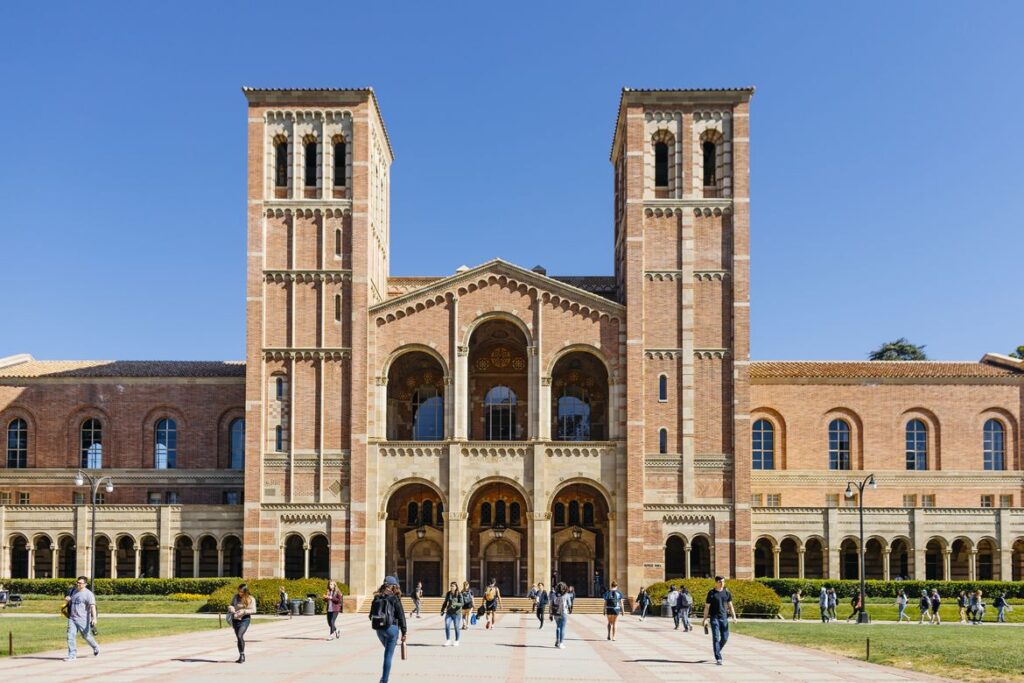
The Samueli School of Engineering, honoring inventor and entrepreneur Henry Samueli, includes seven academic departments centered on the study of engineering and computer science, including Chemical and Biomolecular Engineering, Electrical and Computer Engineering, and Mechanical and Aerospace Engineering.
The School of Engineering dedicates time and energy to innovative research which includes robotics and other forms of artificial intelligence.
UCLA has several research facilities for the study of robotics, including:
- Biomechatronics Lab - studies artificial limbs, specifically hands.
- Bionics Lab - specializes in the involvement of robotics and medicine.
- Computer Graphics and Vision Lab - focuses on computer vision, medical image analysis, and more.
- Information Systems and Theory Lab - studies machine learning, applying information systems to wireless and senor networks.
- Mechanics and Controls Lab - specialized in precision machining.
- Personal and Ubiquitous Robotics Lab - creates custom programmable machines.
- Robotics and Mechanisms Lab - studies humanoid robots, robot locomotion and manipulation.
UCLA also has a team of researchers developing soccer robots.
Stanford University
Stanford, California
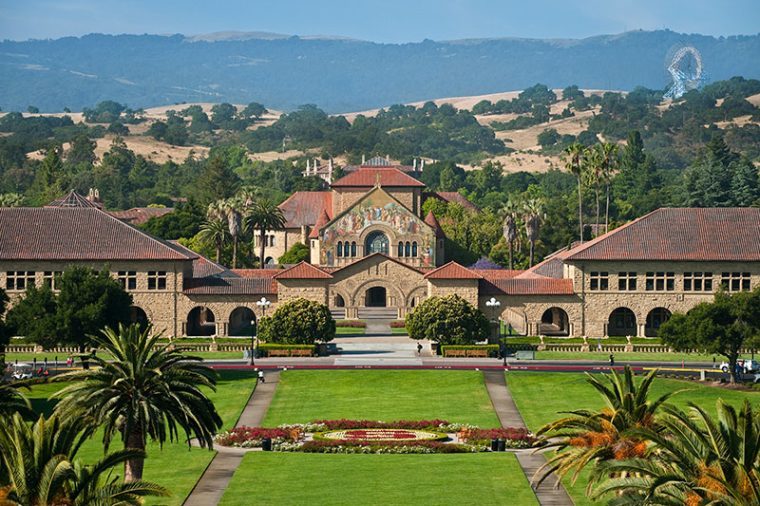
Stanford University has a total enrollment of over 16,000 students. Leland and Jane Stanford established the University in 1885 in memory of Leland Stanford Junior, their only child.
Stanford University offers an online Robotics and Autonomous Systems Graduate Certificate.
Research facilities include the Stanford Robotics Lab and the Stanford Artificial Intelligence Lab (SAIL). Members of the Artificial Intelligence research group have contributed to fields such as computer vision, knowledge systems, decision theory, and bio-information.
Some robotic creations and advancements attributed to Stanford include the Sanford Arm, the Stickybot, OceanOne, flapping robots, Vinebot, and Jack Rabbot.
University of California-Berkeley
Berkeley, California

The University of California, Berkeley - also known as UC Berkeley or Cal - was founded in 1868. The University has over 41,000 students. Berkeley is heavily involved in various research capacities.
Students interested in robotics can participate in the Berkeley Robotics and Intelligent Machines Lab. The Lab manages several research groups including: The Biomimetic Millisystems Lab which seeks to harness features of animal manipulation, sensing and actuation to improve millirobot functionality.
The People and Robots group emphasizes society's interaction with robots focusing on areas such as Bio-Inspired robotics, Deep Learning, and Cloud Robotics. The Robot Learning group researches new and interesting methods for machine learning, perception and control.
Other group options and research areas include the Berkeley Laboratory for Automation Science and Engineering, The BErkeley AeRobot (BEAR) project, the Computer Vision group, Medical Robots, and more.
University of Washington-Seattle Campus
Seattle, Washington
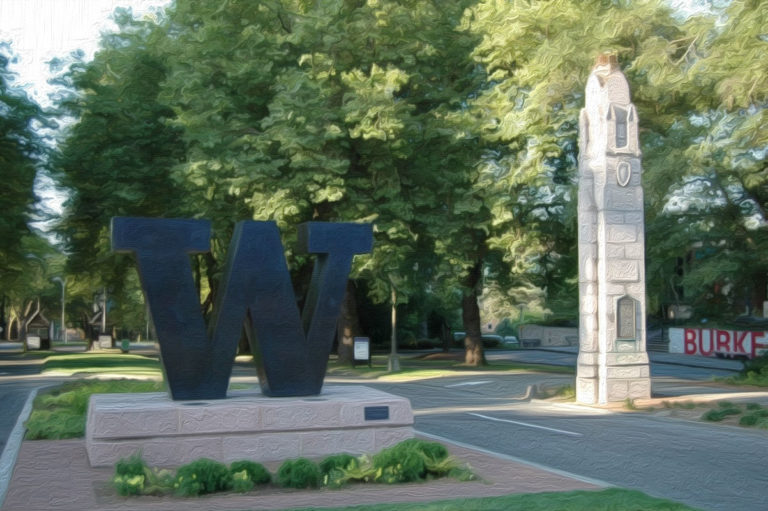
The University of Washington, founded in 1861, located in downtown Seattle, Washington, also has campuses in Tacoma and Bothell. Overall, the University includes over 20 million square feet of space, and over 500 buildings.
The university also has over 26 libraries, making it one of the largest university library systems in the world. The school has over 46,000 students and nearly 6,000 academic staff members.
The Paul G. Allen School of Computer Science and Engineering offers multidisciplinary study of robotics covering a variety of study areas including mechanism design, Bayesian state estimation, biomechanics, neural control of movement, robot learning, and natural language instruction. The robotics research areas includes labs such as:
- Robotics and State Estimation Lab
- Human-Centered Robotics lab
- Movement Control Lab
- Sensor Systems Lab
- Neural Systems Lab
Some courses at University of Washington, applicable to robotics at the undergrad level include the robotics capstone and capstone software - Kinect.
Other affiliated research centers include:
- Institute for Learning and Brain Science
- Center for Sensorimotor Neural Engineering
- Center for Game Science
- Intel Science and Technology Center for Pervasive Computing
University of Maryland-College Park
College Park, Maryland

In 1994 the University of Maryland renamed its School of Engineering in honor of industry leader A. James Clark. Today, the A. James Clark School of Engineering continues in the tradition of hard work, integrity, and ingenuity inspired by its namesake.
The University provides over 20 undergraduate and graduate level degree programs, the majority of which allow students to study robotics. These include the undergraduate majors of Aerospace Engineering, Computer Engineering, Electrical Engineering, and Mechanical Engineering. Students can study the same undergraduate areas at the Master's or Doctoral levels.
The School of Engineering manages several facilities of research including the Institute for Systems Research, which houses the Maryland Robotics Center. This interdisciplinary research facility studies all aspects of robotics including intelligence, component technologies, and system autonomy.
The School of Engineering maintains the Space Systems Laboratory and the Neutral Buoyancy Research Facility. These facilities specialize in astronautics and the simulation of microgravity environments. The University of Maryland has a unique neutral buoyancy tank.
University of Colorado Boulder
Boulder, Colorado

The University of Colorado Boulder offers a variety of undergraduate and graduate robotics related degrees and research areas under the departments:
- Ann and H.J. Smead Aerospace Engineering
- Chemical and Biological Engineering
- Civil/Environmental and Architectural Engineering
- Computer Science
- Electrical/Computer and Energy Engineering
- Mechanical Engineering
Related degrees: Master of Science with concentration in Robotics, a Professional Master's in Aerospace, and a PhD in Robotics and System Design.
Students and faculty involved in robotics system and design research focus on three core competencies: theories of analyzing, synthesizing, and controlling complex systems; methodologies for studying robotic behavior; and technologies related to sensors, perception, and sensor networks.
The University of Colorado Boulder has areas of research strength including autonomy, perception and navigation technologies, surgical robot design, soft robotics, human-robot interaction, artificial intelligence, expendable and automated design and much more.
The University maintains partnerships with sponsored research centers such as the AFOSR Center of Excellence on Nature-Inspired Flight Technologies and Ideas (NIFTI) and the DARPA Subterranean Challenge for faculty and students to network with.
On campus, the Autonomous Robotics and Perception Group focuses specifically on robotic perception.
The Correll Lab studies a variety of smart materials related to robotic sensing, processing, and adapting to new environments.
The Bio-Inspired Perception and Robotics Laboratory focuses on novel perception and mobility approaches.
The Collaborative AI and Robotics Laboratory studies robots that can safely work and learn from humans.
Students may also find support and networking opportunities through the on-campus ATLAS Institute, where engineering and the artistic fields study together.
The ATLAS institute offers a full array of undergraduate and graduate program through the College of Engineering and Applied Science.
Worcester Polytechnic Institute
Worcester, Massachusetts
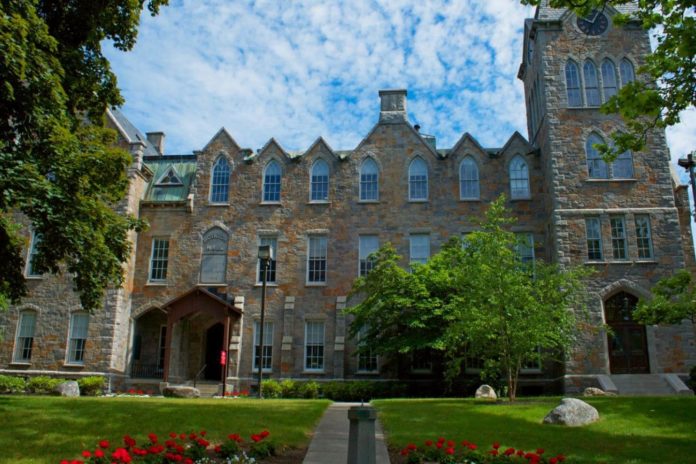
As the first division of its kind in the country, the Worcester Polytechnic Institute Robotics Engineering department offers both undergraduate and graduate level programs.
The Institute offers Robotics Engineering at the certificate, minor, bachelor, master, and doctorate levels. WPI also provides a Robotics Engineering Management certificate program.
In 2016, the Accreditation Board for Engineering and Technology (ABET) awarded the WPI Robotics Engineering Program the inaugural ABET Innovation Award for developing and implementing the first ABET-accredited undergraduate Robotics Engineering program in the United States.
The program was applauded for its faculty commitment to "...bringing a holistic approach to technical education, integrating computer science, electrical, computer engineering, mechanical, and systems engineering."
The Robotics Engineering department maintains these research focus areas:
- Human-Robot Interaction and Interfaces
- Medical and Assistive Robots
- Computer Vision
- Sensing and Perception
- Motion Planning and Control
- Robotic Manipulation
- Novel Sensors/Actuators and Robot Design
- Soft Robots
- AI and Autonomous Systems
- Human Augmentation
- Embedded Systems for Robots
- Multi-Robot Systems
To further explore these research focus areas, the Robotics Engineering Program is supported by 15 state-of-the-art labs and three teaching labs that promote innovation, collaboration, and integration of research and education.
Massachusetts Institute of Technology
Cambridge, Massachusetts

Massachusetts Institute of Technology (MIT) founded in 1861, is a private research university. The school mascot, Tim the Beaver, represents the over 11,000 students who managed to be a part of the 7-8% of accepted applicants. The School has always emphasized the importance of early laboratory introduction; researchers began working on computers, radar and inertial guidance during World War II and the Cold War.
There is no specific degree in Robotics at MIT. However, there are a variety of research labs where students can pursue hands-on robotics instruction and research.
These labs include:
- CSAIL
- Biomimetic Robotics Lab
- Interactive Robots
- Edgerton Marine Robotics Team
- MIT Media Lab
MIT also offers free online courses that students can use to teach themselves robotics.
Colorado School of Mines
Golden, Colorado
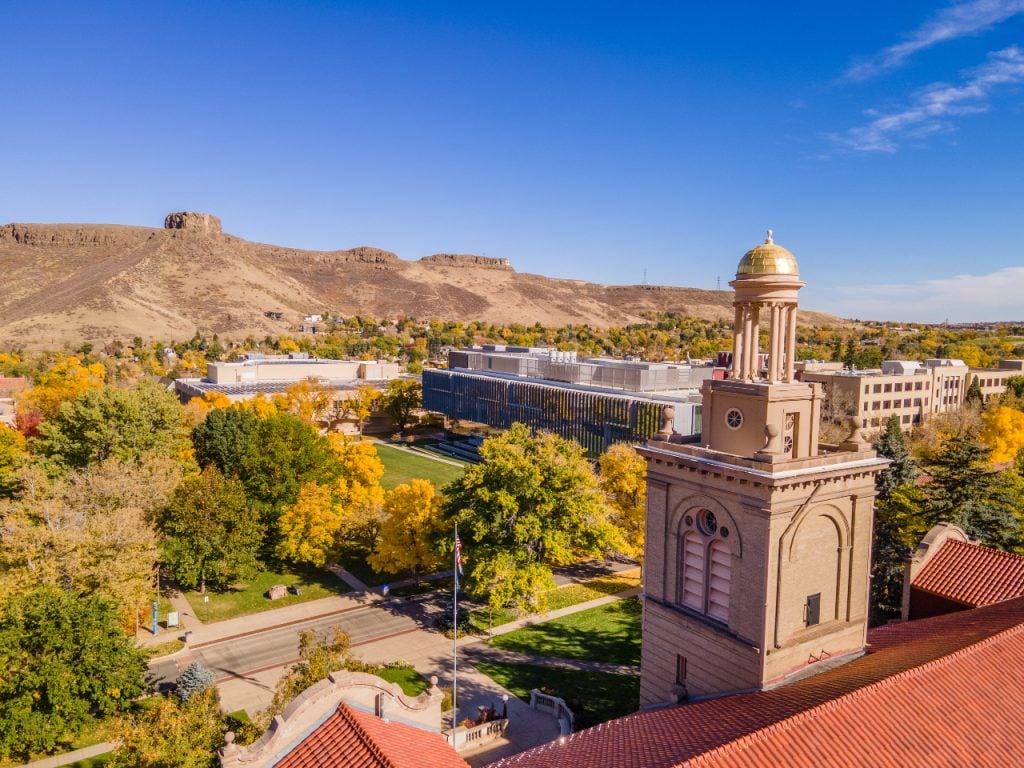
Colorado School of Mines, a public school devoted to applied science and engineering, places special emphasis on the development and stewardship of the earth's natural resources. The School, established in 1874, has almost 6,000 students.
The Colorado School of Mines has a research group within the Mechanical Engineering department devoted to Robotics, Automation and Design (RAD).
The group studies a wide range of topics as they relate to RAD, including classical operations research, medical robotics, automation and machine-user interface studies as they relate to medicine, infrastructure inspection, remote exploration, and rehabilitation.
The group delves into design and optimization, specifically complex scheduling and managing integrated systems - especially how they might apply to energy and mining sectors.
Virginia Polytechnic Institute and State University
Blacksburg, Virginia
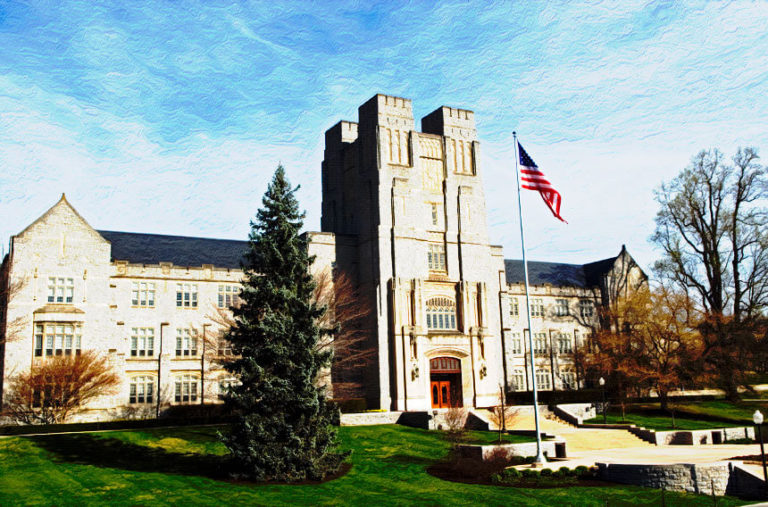
As a technical school, Virginia Tech has a heavy emphasis on hands-on learning, especially with the sciences. The College of Engineering is home to the Mechanical Engineering department.
The College considers Mechanical Engineering as the most comprehensive of the engineering fields, covering a variety of technologies and disciplines including robots, satellites, artificial organs, acoustics, energy management, fluid mechanics, and much more.
Students can pursue bachelor, master, and doctoral level studies in Mechanical Engineering. The College of Engineering offers students study abroad opportunities with international programs with connections to China and Australia. The College also has a unique nuclear engineering program and Nuclear Science and Engineering Laboratory.
Through the Terrestrial Robotics Engineering and Controls Lab students study robotics in relation to natural disasters and every-day life.
A research team in connection with the Lab and the Office of Naval Research's Shipboard Autonomous Firefighting Robot program developed the world's first fire-fighting humanoid robot.
The Mechanical Engineering department also manages the Robotics and Mechatronics Lab.
Here students can study areas such as robotic intelligence, vision, system dynamics and control, human-robotic interactions, machine learning, industrial automation, and more.
Brown University
Providence, Rhode Island
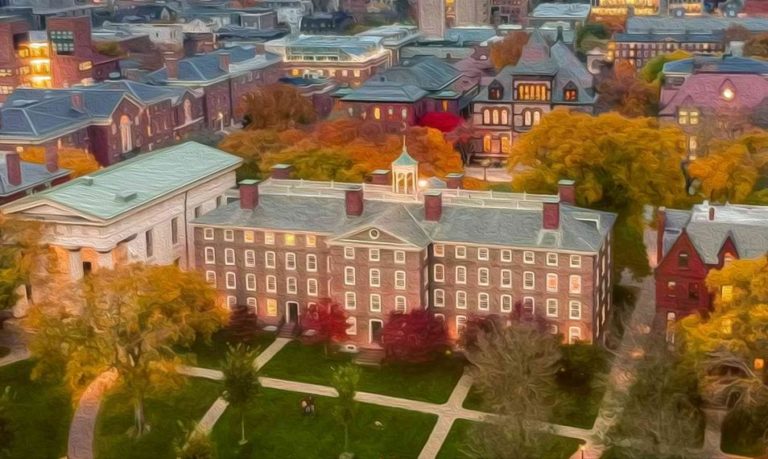
Brown University, a private Ivy League University founded in 1764, is the seventh-oldest institute of higher learning in the United States. Brown University was the first college in the United States to welcome students regardless of their religious association.
The University has more than 9,000 students, of which 6,500 are undergrads, and over 700 academic staff members.
In 1969, after extensive student lobbying, Brown adopted a new style of education which does not require any "general education" courses. Students gain control of their own education through creating their own syllabus.
Students can also complete any class with a result of either "satisfactory" or "unrecorded no credit". Brown University offers a specialized path for Robotics through the Computer Science department.
Work in the robotics field of research is done with an inter-disciplinary emphasis with the disciplines such as Engineering. The Robotics group has a goal to bring to fruition robots which effectively collaborate with humans, and to that end, the group studies topics such as robotic learning and perception, autonomous control, and human-robot interaction.
The Robotics group is led by faculty who are each responsible for different robotics initiatives which currently include Humanity Centered Robotics Initiatives, Humans 2 Robots Lab, Intelligent Robot Lab, and the RLAB (reinforcement learning and adaptive behavior) Group.
The group also has access to numerous labs and a number of robots to aid in their studies.
The University of Texas at Austin
Austin, Texas
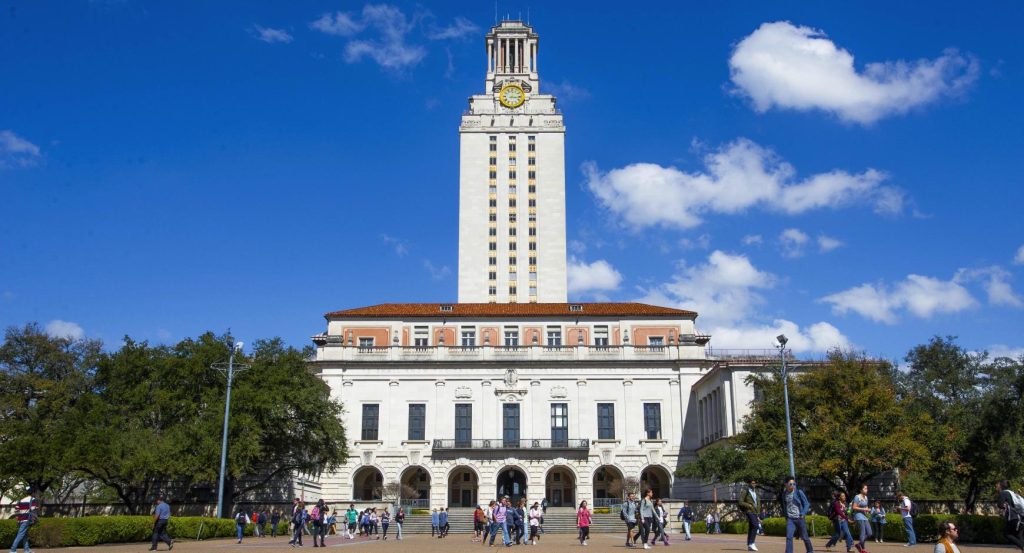
The student body at the University of Texas at Austin, is one of the largest in the United States, with over 50,000 students. The University also has over 24,000 faculty members. The University includes seven museums and 17 libraries.
The University of Texas at Austin recognized the rapid growth of the robotics field; the University, beginning in the 2015-2016 academic year, began offering a graduate portfolio program in Robotics, which provides students an opportunity to have their extra coursework in robotics recognized on their diploma.
This program requires core coursework like autonomous robots, human robot interaction, decision and control of human-centered robotics. The University of Texas at Austin has also defined other courses approved for the program.
These include but are not limited to natural language processing, scalable machine learning, human-computer interaction, brain, body and robotics, and geometry of mechanisms and robots.
Students can attain the robotics program through their home college during their Master's or PhD program.
University of Massachusetts-Amherst
Amherst, Massachusetts
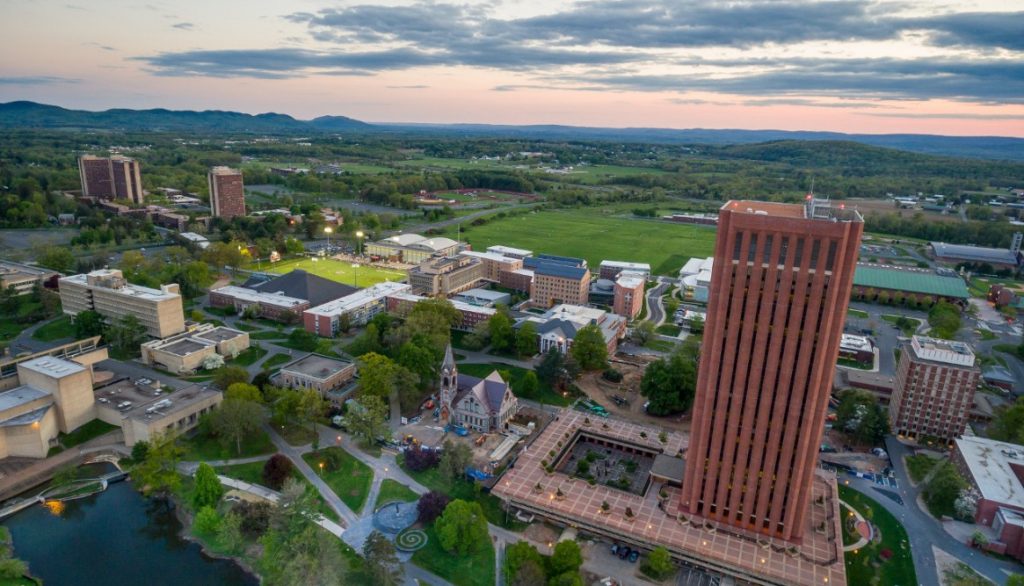
The University of Massachusetts Amherst, a public university which has over 30,000 students, offers over 110 undergraduate degrees, over 70 master's degrees, and nearly 50 doctoral programs.
UMass Amherst offers a Mechatronics and Robotics Research Laboratory (MRRL) as part of their Mechanical and Industrial Engineering department. In the MRRL, studies focus on developing physically interactive mechatronic systems.
Students in the lab research human-centered robotic technologies and human-machine interfaces.
Within the College of Information and Computer Sciences, UMass Amherst has implemented a research area specific to robotics, computer vision and graphics.
This research division specifically examines the computer interface with the real world and how people and the world around them can naturally interact with computers.
In order to achieve this goal, computers must have the ability to relate to their surroundings - through either physical or visual (or both) interactions.
Professional Robotics Organizations
Robotics Industries Association (RIA):
The Robotic Industries Association (RIA) is involved in growth, innovation, and safety in manufacturing and service industries via promotion, education, and advancement of robotics, companies providing integrated solutions and related automation technologies. Member companies of the Robotics Industries Association include leading robot manufacturers, research groups, users, system integrators, consulting firms and component suppliers. Robotics Online provides information to help engineers, managers as well as executives apply and justify robotics and flexible automation.
IEEE Robotics & Automation Society:
The IEEE Robotics and Automation Society (RAS) strives for the advancement of the theory and practice of robotics and automation engineering and science as well as the allied arts and sciences. RAS strives to advance innovation, education, as well as fundamental and applied research in robotics and automation.
The Student Activities Committee of the IEEE Robotics and Automation Society (SAC):
provides students opportunities to advance their careers and improve their professional experience. SAC organizes events to provide students opportunities to obtain high quality information. SAC also provides students with opportunities to meet and interact with leaders of academia and industry.RAS holds meetings for presenting and discussing papers and sponsors applicable periodicals and special technical publications.
Society of Manufacturing Engineers:
The Society of Manufacturing Engineers (SME) provides support and resources for manufacturers. The organization includes professionals, educators, and students interested in promoting and supporting the manufacturing industry. SME provides manufacturing technology resources and news, and produces events. The Society of Manufacturing Engineers provides training and development solutions for the workforce. The organization also provides student outreach and scholarship programs.
Association of Manufacturing Technology (AMT):
The Association for Manufacturing Technology (AMT) represents and promotes U.S.-based manufacturing technology and members of the association who design, build, sell, and service technology for manufacturing. AMT provides events and operates the International Manufacturing Technology Show. AMT also provides global support.
International Society of Automation:
The International Society of Automation (ISA), a nonprofit professional association, sets the standard for individuals who apply engineering and technology to improve the management, cybersecurity and safety of modern automation and control systems utilized across industry and vital infrastructure. ISA creates global standards; provides education and training; certifies industry professionals; publishes books and technical articles; hosts conferences and exhibits; and offers networking and career development programs for its members and customers throughout the world.
International Federation of Robotics (IFR):
The International Federation of Robotics (IFR) connects the world of robotics throughout the world. The IFR has members from the robotics industry, national or international industry associations as well as research & development institutes. The International Federation of Robotics assists manufacturers and integrators of robotics to enter new markets, provide worldwide market data for surveys, studies and statistics, stimulate research in the robotics field and promotes links between science and industry. The IFR sponsors the International Symposium on Robotics ISR - a conference on industrial and service robotics.
Robotics Colleges Ranking Guidelines:
We selected the best robotics colleges based on academic excellence, reputation, faculty strength and the range of robotics-related courses, and associated Robotics instruction opportunities such as labs. Colleges and universities with either undergraduate and/or graduate degrees in Robotics are ranked higher than schools that offer certificates or research opportunities in labs but don't offer degrees.
Robotics Career Information
The Bureau of Labor Statistics lists Robotic Engineering under the title of Mechanical Engineers. Mechanical Engineers has a median salary of $99,510.00. The projected growth rate is 11%, adding 31,200 new robotics positions over the next ten years. The typical minimum degree required is a bachelor's degree.
More resources:
- The Best Artificial Intelligence Colleges
- The Best Colleges for Online Artificial Intelligence Boot Camps
- The Best Online Master's Degrees in Machine Learning
- The Best Online Artificial Intelligence Degrees
- The Top Artificial Intelligence Colleges in Texas
- The Best Artificial Intelligence Journals
- The Best Video Game Design Colleges
- The Best Online Video Game Design Colleges
- The Best Bachelor’s in Computer Science: Game Design Degrees
- The Best Online Computer Science Degree Programs
- The Best Online Master’s in Information Technology
- The Best STEM Degrees for Careers of the Future
- The Best Online Degrees To Get For Careers
Frequently Asked Questions:
What is Robotics?
Robotics is the science and technology field behind the design, manufacturing and application of making robots. Robotics, an interdisciplinary field, includes the fields of mechanical engineering, electrical engineering and computer programming.
Robotics professionals develop and apply robotic solutions to a wide range of industrial and consumer issues. Robotics collaborates artificial intelligence with robots to allow robots to react and respond to their surroundings in real time, without guidance other than computer programming.
Companies use robots in arenas, dangerous for humans (such as defusing bombs), however companies increasingly use robots in fields to fill labor roles in manufacturing, complete tasks in healthcare, and serve as receptionists, guides, and helpers. Robots are also utilized for domestic or household use.
What is a Robot?
A robot is a programmable mechanical device with the ability to perform tasks and interact with its environment, without the aid of human interaction. Robots can sense, compute, and act. Some robots can move around; some robots can manipulate things; whereas some robots can move around and manipulate things. Robotics engineers design some robots to perform specific tasks, whereas some robots can perform many different tasks.
What is Mechatronics?
Mechatronics focuses on the design process of mechatronics combines mechanical, computer, and electrical engineering along with systems integration and technical project management. Mechatronics engineering includes the design, construction and operation of automated systems, robots and intelligent products, which result from the incorporation of software and hardware. Robots are mechatronic devices. A surgical robot, performing precision mechanical work under sophisticated electronic and sensory control, is an example of a mechatronic system.
What is the Salary for Robotics Engineers?
The Bureau of Labor Statistics lists Robotics engineers as Mechanical Engineers. Mechanical Engineers can anticipate an average salary of over $90,000. Projected job growth in the robotics engineering field is expected to grow 4% between now and 2029, adding 12,400 more positions.
The world today is just tapping into the potential for robotics and all the ways the sophistication of models and computer programming can improve the environment and world. Today's robots are working toward speech recognition, artificial emotions, personality, gestures, and social intelligence. Much of the research conducted now focuses more on what kind of new robots professionals can create and new ways to create them.
Some of the careers someone interested in robotics may explore include robotics engineering, software development, robotics technician, even sales engineers. The increasing number of industries utilizing robots has increased the demand for more engineers and software professionals.
What industries use Robotics?
Some of the industries employing robotics professionals include: Aerospace, Agriculture, Architectural and engineering services, Automation integrators, Automotive industry manufacturers, Chemical, Electronics, Energy, Federal and state Agencies, Food processing, Healthcare, Homeland security, Hospitals and health care, Manufacturing, Military, Mining, Pharmaceutical, Processing Plants, Research, Semiconductors, Steel mills, and Transportation.
What are Robotics education requirements?
Colleges and universities provide robotics-related undergraduate and graduate degree programs. Some schools provide robotics engineering undergraduate degrees, however, many schools don't provide full-fledged robotics degrees but provide undergraduate and graduate-level courses in robotics.
Many community colleges provide robotics programs for individuals interested in a robotics technician career. Students with a major in robotics engineering technology, learn to develop and apply robotic solutions to a wide range of industrial and consumer issues.
Robotics engineers typically need to have at least bachelor's degrees for entry-level jobs in the robotics field. Many robotics professionals have a degree in electrical engineering, mechanical engineering or computer science. Some of these robotics professionals also have another degree or expertise in human-computer interaction or psychology.
Many robotics professionals have advanced degrees. Robotics professionals typically receive education in areas such as: Artificial intelligence, Bioengineering, Computer programming for robotics, Computer systems, Computer visions, Construction, Design, Electronics, Information processing, Machine learning, Mechatronics, Motion planning, Nanotechnology, Robotic engineering, and Sensory feedback.
What are some degree majors for learning Robotics?
Mechanical engineering: Mechanical engineers oversee the physical system of a robot. The physical system includes the pieces of robots such as motors and actuators. The physical system also includes how the robotic arm functions in a production environment. Mechanical engineering also includes physical operating protocols and safety measures.
Electrical engineering: This area of engineering provides the electronic foundation for robots, including the low-level circuit programming, embedded systems, electrical resistance, and control theory. Electrical engineers interested in robotics typically receive an education more focused on the control of robots rather than their mechanical design.
Computer science engineering: Many engineers in the robotics field enter through the world of computer science. This group of robotics professionals focus on the software and programming language instead of hardware. This field includes subjects such as artificial intelligence (AI) and machine learning.
Robotics specializations:
- Aerial robotics
- Agriculture and forestry robotics
- Artificial intelligence
- Autonomous robots
- Bio-Inspired robotics
- Collaborative robotics
- Computer-aided design
- Computer vision
- Construction robotics
- Domestic robotics
- Electrical theory
- Embedded systems for robots
- Feedback control systems
- Field and services robotics
- Geometric control
- Human-robot interaction
- Human augmentation
- Industrial robotics
- Integrated robotic systems
- Intelligent transportation systems
- Kinematics
- Learning and communication in multi-agent systems
- Legged locomotion
- Machine perception
- Manufacturing
- Marine robotics
- Medical and assistive robotics
- Micro-aerial vehicles
- Mining robotics
- Mobile robots
- Modeling/optimization for energy conversion and use
- Modular and reconfigurable robotics
- Molecular robotics
- Motion planning and control
- Multi-robot coordination
- Multi-robot systems
- Personal and assistive robotics
- Prosthetics
- Rehabilitation robotics
- Robot navigation
- Robot perception and computer vision
- Robot structures
- Robotic mapping and navigation
- Robotic sampling and surveying
- Robotics for scientific discovery
- Search and rescue robotics
- Sensing and perception
- Sensor technology
- Service robotics
- Soft and micro-robotics
- Space robots and systems
- Surveillance and security
- Swarm robotics
- Robotic dynamics
- Transportation
- Underwater robotics
- Unified robotics
- Urban search and rescue
Who provides Robotics certification?
Kuka provides the Kuka Official Robotics Education (KORE) certificate program. They designed the program to offer it to high schools, community colleges, universities, and vocational schools. The program teaches students basic robot programming and operation skills, based on project-based activities that mimic real-world manufacturing.
FANUC Certified Education for Advanced Automation provides training in automation techniques to high schools, colleges, and universities. The FANUC CERT training provides education in robotics as well as in CNC machining and robotic drilling. Engineering professionals have access to both of the programs at certified training locations.
What are the professional organizations in the field of Robotics?
The professional organizations for Robotics are: Robotics Industries Association (RIA), IEEE Robotics & Automation Society, The Student Activities Committee of the IEEE Robotics and Automation Society (SAC), Society of Manufacturing Engineers (SME), Association of Manufacturing Technology (AMT), International Society of Automation, and the International Federation of Robotics (IFR).
What are some career positions for Robotics Engineers?
Robotics engineering careers include areas such as Assistive technologies, Control system design, Embedded system design, Remote sensing, Robotics and autonomous systems, Signal/image/video processing, Intelligent, collaborative, and adaptive robots, Precision and remote surgery, Office and consumer appliances, and Environmental remediation. Robotics job titles: Applications Engineer, Automation Engineer, Automation Engineer, Automation Engineering Manager, Control Systems Engineer, Design Engineer, Factory Automations Engineer, Manufacturing Engineer, Mechanical Engineer, Robotic Process Manager, Robotics and Systems Lead, Robotics Engineer, Robotics Software Engineer, Robotic Systems Engineer, Software Automation Engineer, Software Engineer, Software Engineer Systems Engineer, and Systems Engineer.
What college has the best robotics program?
Carnegie Mellon is the best robotics college in the nation in our ranking. Entrenched in the world of robotics since 1979 when they opened The Robotics Institute, Carnegie Mellon offers robotics-related degree options as a major, a minor, a bachelor of science, a master of science, and a PhD program. The Robotics Institute has been conducting research in a vast array of areas, including aerial robotics, mining robotics, robotics in construction, search and rescue robots, and underwater robotics.
